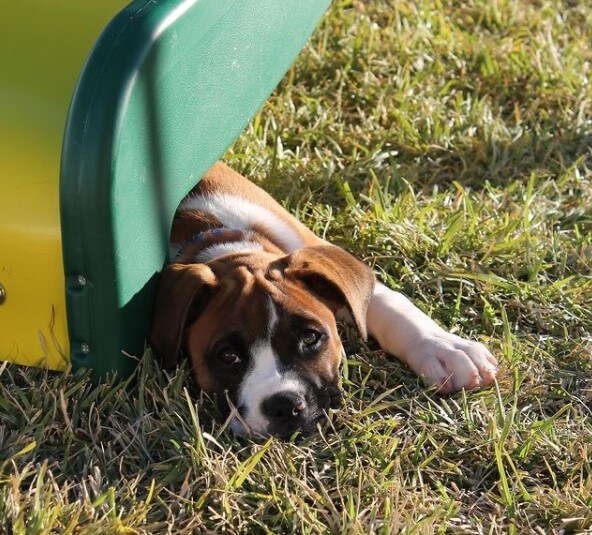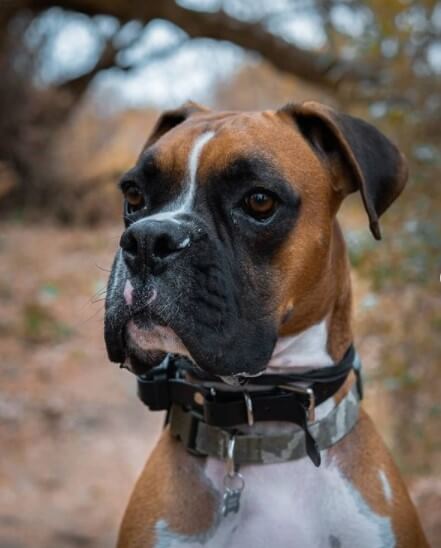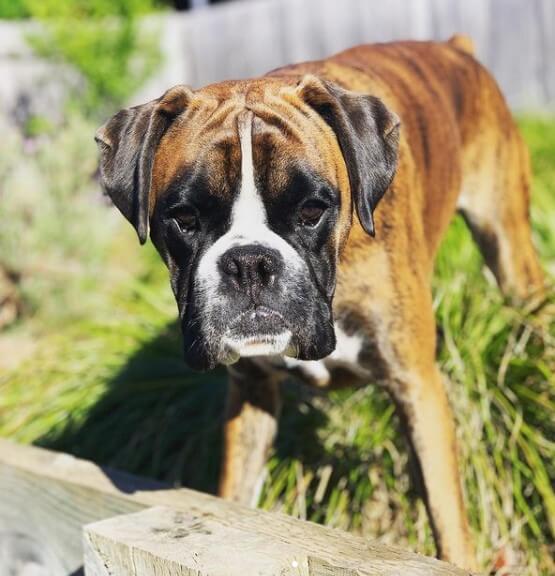German Boxers are used as bodyguard dogs, as watchdogs, and in law enforcement. Representatives of this breed are smart and balanced, which allows them to be used as guides for the blind. The Boxer dog is very mobile by nature, loves to be outdoors, to walk for a long time, to frolic in the open air. Despite her sociability and friendliness in relation to the owner and family members, her attitude towards strangers is cautious, and she is wary of them.
Brief Information
- Breed name: Boxer
- Country of origin: Germany
- Time of origin of the breed: 1850 year
- Weight: males ~ 30 kg, females ~ 25 kg
- Height (height at withers): males 57-63 cm, females 53-59 cm
- Life span: 11-12 Years
Highlights
- A bright temperament and at the same time an agreeable character and a strong nervous system – these features are most fully expressed in German Boxers.
- The Boxer is an excellent watchman and all thanks to his courage and fearlessness.
- Dogs of this breed are very sociable in the family circle, they love it when the owners are attentive to them, show friendliness to all household members.
- Affectionate Boxer is a real find for families with small children. He will gladly play with them, and then willingly lie down on the sofa (including with adults) to relax together.
- Boxers often treat strangers with distrust: when guests appear in the house, they begin to bark loudly. Socializing the animal from an early age will help solve this problem.
- The proper upbringing of a boxer is a guarantee that a loyal and devoted friend will grow out of a puppy.
History of the Boxer Breed
The ancestors of the German boxer are Bulldogs, Mastiffs, and Bullenbeisers. It was as a result of the mixing of their blood that this breed was born, which began to conquer the world in 1896.
Boxers from the late 19th century and modern boxers are not exactly the same thing. In those early years, they were used as shepherds, for transporting goods and hunting wild boars and bison. Often, early representatives of the breed became participants in dog fights and even bullfights. During the First World War, the German army successfully used them as postmen and scouts. At the same time, the German Boxers showed themselves as guide dogs. Later, the dogs of this breed also revealed their “creative” talents, successfully performing in the circus and theatrical performances.
An interesting version of the earlier origin of Boxers. Some researchers claim that their direct ancestors are the Tibetan Mastiffs, which appeared in Rome and Greece in ancient times. It is believed that the ancient Boxers were larger and more aggressive. Their inherent bloodthirstiness helped them cope with military tasks. They were used for protection and as a pickling dog during the hunt for large forest game, as well as in the popular entertainment of those times – dog fights, which, in terms of the intensity of passions, were practically not inferior to gladiatorial ones.
From the end of the nineteenth century, the German Boxer began to conquer the world, he had many fans in different parts of the world, even opening clubs dedicated to this incredibly stately, handsome, and handsome dog. Her appearance seems aggressive (sometimes it may seem that she is ready to rush at a stranger and tear him apart), but behind her hides good nature and docile nature. This is a great merit of the breeders, who did everything possible to add such traits as kindness and poise to agility, endurance, and quick reaction.
Breed Name
When the dog wants to play, he begins to touch his paws in the air, as if boxing. Such a special manner, which makes her, unlike other dogs, predetermined the name of the breed. According to the owners, Boxers have all the necessary qualities to live in a family, so they are the best!
Features of the German Boxer
The German Boxer at the age of 18 months is already an adult dog, fully formed physically. However, the inner world by the age of one and a half still remains “childish”. For this reason, attempts to train a dog during the period of his emotional immaturity are practically unpromising, that is, he does not respond to commands, the owner even begins to think that he is communicating with a deaf person. But at one point in training, a breakthrough comes, and your pet suddenly begins to understand everything that they tried to teach him before, but in vain.
The Boxer is a sociable dog, he gets along easily with other four-legged inhabitants of the house, but sometimes the cocky character takes over and she starts chasing the yard cats. It happens that a dog of this breed easily gets involved in a fight with other dogs, and he often provokes fights himself. By nature, the Boxer is a real fighter, he is agile, courageous, and strong. If trained properly, you can raise an excellent guard. The childish spontaneity inherent in Boxer stays with him all his life. The dog shows enviable stubbornness but never achieves its goal with aggression. His main weapon is humor and charm, before which no loving owner can resist.
Representatives of this breed have amazing sensitivity, they are very smart and cunning. Sometimes they are noisy, which is perceived by some owners as a disadvantage, therefore, in order to develop the best character traits and minimize disadvantages, it is imperative to train Boxers. With the right approach to this task, you can achieve amazing results, as Boxers perceive training as a game and easily succumb to it.
Appearance
Boxers have a stocky build. They are also called “square” dogs because their height and length have approximately the same values. A wide and deep chest, coupled with a strong back with a slight slope in the pelvic region, is quite consistent with this type of physique. However, representatives of this breed do not look squat – rather the opposite. Dogs look stately, they have a proud posture and all thanks to dry muscles and a lean stomach. Their limbs are massive, correctly set, without curvature, so the “figure” is not spoiled. The Boxer’s neck is of medium length, strong and muscular, and the tail is long and straight.
A distinctive feature of the breed is a slightly protruding lower jaw, a slightly upturned nose, and high set ears – thin, slightly hanging forward. When cut (docked), they acquire a pointed shape, which gives them the correct setting. The Boxer’s eyes are dark, intelligent and tell a lot about the breed. Curiosity is read in the look, it glows with energy, but not aggression.
Boxers’ skin, with the exception of the forehead and cheeks, is tight and does not form any folds.
Coat and Color
The Boxer’s coat is short, coarse. Only two colors are considered classic for German Boxers: red and brindle. The first can vary from deep red to light yellow shades. The brindle has its own “extremes”: from golden to gloomy dark. The breed standard dictates that the stripes should be in clear lines.
Whatever the color, a kind of dark mask is an invariable attribute on the dog’s face. The presence of white markings, giving the breed aesthetics, is acceptable.
Boxer Personality
Cheerful, playful, curious, cheerful, energetic – these are the traits that characterize German Boxers in full measure. And also these dogs are loyal, very strongly attached to their owner and members of his family. Positive traits remain with Boxer all his life, he likes it when there are a lot of people and noise around.
A Boxer who has gone through a good training school gets along well with young family members, treats them carefully, never offends, and plays with them with pleasure. He will not only become an excellent companion for your child, but also a reliable guard.
With a good upbringing and social adaptation, a representative of this breed will get along well not only with other dogs living in the house but even with cats. However, animals and birds are real “temptation” for them. Your pet can be taught not to touch them, and he will not do this in your presence. But, it is better not to leave the boxer alone with the pets.
The Boxer loves to fool around, warmly welcome all the people he knows. He never loses vigilance and therefore he will be a good defender for his household. This brave, athletic breed retains excellent guarding and watchdog qualities at times to a ripe old age. In order for the dog not to show its not the best qualities – excessive noise, stubbornness, and sometimes uncontrollability – he needs a master who will dominate over him.
Adults have a calm temperament, which is a direct result of proper training at an early age. The popularity of the breed is precisely due to this very poise, coupled with natural intelligence and tolerance for people and other pets. In relation to his master, the Boxer shows the most tender feelings, and all his looks show that he really likes to be around. If you do not cultivate communicative qualities in him, the dog will be suspicious of strangers all his life, bark at them, refuse to let them near the owner.
The Boxer retains childish activity and spontaneity until the age of 2-3, although physically he matures by one and a half years. Many owners, unaware of the intricacies of the breed, complain that the Boxer does not understand the commands he is being taught. In fact, it takes a dog time to absorb and consolidate the new information. The owners are then convinced that this is so: at one point, the dog begins to do everything that seemed to be uselessly taught him for a long time.
Training
Boxers are smart, well-trained dogs. At the same time, they are stubborn and selectively perceive new information for themselves. They refuse to carry out many commands, preferring to obey only those that they like.
Some owners believe that it is necessary to train a representative of this breed by the “carrot and stick” method, that is, punishing for disobedience and rewarding for the exact execution of commands. However, the “whip” in this technique will be superfluous, since Boxers react badly to punishment. Various rewards (praise, treats, rewards) make them more receptive to training. Using a specific set of commands, in the process of training, you will definitely achieve excellent results. With the correct and intelligible formulation of the tasks, the Boxer remembers the learned commands for a long time.
Boxer education usually begins from the moment the puppy is in the house and full training – from three months.
Conditions of Detention and Care
The Boxer is very fond of the expanse, so the countryside suits him perfectly. But even in the apartment, your four-legged friend will feel good if you regularly take him out for walks in a large park, where he can walk for a long time. The dog will be an excellent companion for the owner who loves morning or evening runs. He is ready to spend at least the whole day outdoors.
In general, German Boxers are quite unpretentious in grooming, but they do not tolerate cold and high humidity.
Since Boxers’ coat is short, it, unlike long-haired breeds, does not get tangled or tangled, and therefore does not need frequent combing.
It is not recommended to bathe Boxers often. If your pet gets dirty during active games, just wipe the dirty place with a damp cloth.
Since the Boxer is by nature very active, a sedentary lifestyle is contraindicated for him, he should receive maximum physical activity. For the healthy development of this breed, a balanced diet is also required.
The eyes of the dog require special attention. Lacrimal secretions or dust often accumulate in their corners, and a soft handkerchief is enough to remove them. If your dog’s eyes are red, a soothing ointment will help. However, do not self-medicate: the drug should be prescribed by a veterinarian.
Dirt can build up in the ears. To remove sulfur and dust from the auricle, just wipe it with a handkerchief wrapped around your finger or wipe it with a damp swab. It is strictly forbidden to clean Boxer’s ears with a cotton swab or instill alcohol in them.
The Boxer’s claws must not touch the floor when walking. Otherwise, they need to be cut. For this purpose, special forceps are used. The procedure should be carried out no more than twice a month, otherwise, you will cause discomfort and pain to your pet.
Health
Despite the fact that Boxers can live 11-12 years, on average, they rarely live to 10 years. The reason lies in a weak immune system. Since these dogs are uncomfortable in low temperatures, they are prone to hypothermia, colds, and allergic diseases. For their health to be safe, the premises in which German Boxers are kept must be dry and free from drafts. In wet and windy weather, it is better to refrain from walking.
The most common diseases of this breed include the following: heat intolerance, allergies, deafness, benign and malignant tumors, twisting of the stomach, hypothyroidism (decreased thyroid function), arthritis, heart problems, dysplasia (hip and elbow joints), degenerative myelopathy ( as a result of this ailment, paralysis of the lower extremities is possible).
How to Choose a Puppy
In addition to compliance with the breed standard, an important criterion for choosing a future pet should be the compliance of his character with yours. Also, you must initially decide for what purpose you choose the German Boxer. If you are not aiming to participate in various exhibitions and just want to breed, a sociable companion dog will do just fine. The puppy should show his playfulness, friendliness, and desire to communicate with you.
The Boxer is perfect for active, cheerful people because this is a sports dog. Even if you choose a “non-elite” puppy, communication with him and training will bring a lot of pleasure. For him, many kilometers of jogging is not a problem, he will be a good company for you on hikes and excursions to hard-to-reach places.
You should definitely inquire about the health of your future pet, whether he was tested for deforming spondylosis, hip dysplasia, behavioral abnormalities, and eye diseases. Any of these ailments is a real danger to Boxers and can even cause the death of a dog. It will not be superfluous to demand from the breeder a document in which the results of the litter survey are recorded in order to find out how many puppies have not passed the commission. If the number of those turns out to be high, it is better not to take the puppy, as there is a risk of passing on defects to the offspring.











